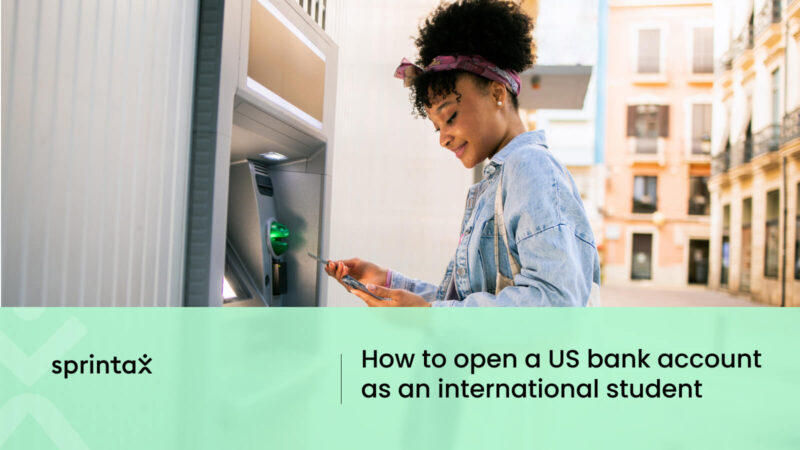As an international student traveling over to the US, you will likely have considered the possibility of opening a US bank account.
After all, doing so has many advantages – for example, it will be easier to manage your finances and cheaper than withdrawing money from a foreign bank account.
You can also pay your bills online or by check, and use credit cards without the hassle or hefty international banking fees.
In this blog, we’ll discuss some of the options for opening a US bank account as an international student!
Can an international student open a bank account in the US?
Yes, international students can open a bank account in the US.
When opening a bank account, you’ll generally be required to provide two forms of identification as well as your tax identification number. You also can’t open a bank account with no proof of address, so ensure you bring this with you too.
It’s very difficult to open a bank account in the US from abroad, and you will likely need to stop into your local branch when you arrive.
As well as this, while there is an outside chance that they may allow you to open a bank account online without an SSN or ITIN, most banks will require one.
Not got your SSN or ITIN? No worries! You can always prepare your application forms for SSN and ITIN with Sprintax Forms!

Why do international students need to open a US bank account?
There are many positives to opening a US bank account online or in-person as a nonresident.
Here are some benefits of opening a US bank account:
Convenience of daily expenses
A US bank account makes it easier to manage day-to-day expenses like paying for rent, groceries, and utilities.
Using a US debit card allows you to avoid the hassle and fees associated with converting foreign currency. As well as this, most banks offer excellent online and mobile banking services, allowing you to transfer money, pay bills, and monitor your account at any time.
Avoid transaction fees
If you use an international credit or debit card for purchases in the US, you are often charged foreign transaction fees and possibly poor exchange rates.
By having a US bank account, you can avoid these extra charges.
Lower fees for International Transfers
Having a US bank account allows your family or sponsor to send money to you through wire transfers at potentially lower fees.
Some banks have partnerships with international banks that reduce costs further.
Tuition payments
Most universities accept tuition payments directly from US bank accounts.
This streamlines the payment process and can help avoid complications with foreign payments or exchange rate fluctuations.
How to open a bank account as an international student
While documents are required to open a bank account for international students at all banks, some may require more than others.
In general, you will need the following documents in order to open a bank account in the US:
- A current passport;
- Proof of address (e.g., utility bill, apartment contract);
- College address (e.g., enrolment verification letter);
- An identification number, such as one or more of the following;
- A taxpayer identification number;
- A passport number and country of issuance;
- An alien identification card number;
- Number and country of issuance of any other government-issued document showing nationality or residence and bearing a photograph or similar safeguard.
Remember, some banks may ask for additional documentation to establish your identity, such as:
- I-94 card
- I-20, DS-2019, or I-797 approval notice
- Another form of identification, such as a foreign driver’s license or credit card
- Form W-8BEN if you’re not eligible for an SSN or ITIN.
- Once you open the bank account, you’ll need to make a deposit to activate the account.
What is the difference between a checking and savings account?
When it comes to opening a new bank account, nonresidents will usually choose between a checking and a savings account.
There are some big differences between the two, however, so it’s important to know which one to open.
In short, you’ll use a checking account for:
- Everyday expenses
- Daily withdrawals
- Access using checks, automated teller machines and electronic debits
- Examples include student accounts, business accounts, and joint accounts
Checking account
With a checking account, you will be able to carry out all necessary day-to-day spendings.
This is the perfect type of bank account for international students to use for expenditure such as groceries, online shopping, or leisure activities. Typically, there is little to no interest on any funds you have deposited.
Savings account
On the other hand, savings accounts are designed for short or long-term savings.
Opening a savings account makes sense if put some cash away for a bigger purchase, like a television, computer, or new phone.
A savings account has the following features:
- Good for long-term investments
- Requires a minimum deposit
- A limited number of free transactions

Best bank for international students in the USA
Choosing the best bank as an international student in the US depends on factors such as fees, services, ease of opening an account, and your banking needs.
Here are some of the best banks for international students based on those factors:
Chase Bank
Why it’s great for international students:
- Widely accessible: Chase has over 4,700 branches and 16,000 ATMs across the U.S., making it easy to find a location.
- No monthly fees for students: Chase offers a “Chase College Checking Account” for students aged 17-24, which waives the monthly fee for up to five years while you’re enrolled in school.
- Online banking: Chase has a robust mobile app and online banking platform, making it easy to manage your account remotely.
- International transfers: Chase supports international wire transfers, which is helpful for sending or receiving funds from home, though fees may apply.
Bank of America
Why it’s great for international students:
- Student-friendly accounts: Bank of America offers a “Student Checking” account with no monthly fees as long as you’re a student under 24.
- Extensive branch network: Bank of America has over 4,000 branches and 16,000 ATMs nationwide.
- Zelle for peer payments: Bank of America integrates Zelle into their online and mobile banking for easy and fast person-to-person payments (great for splitting rent or bills).
- Support for international students: Generally known to be accommodating to international students and may accept alternative forms of ID (such as a passport) when opening a Bank of America nonresident account.
Wells Fargo
Why it’s great for international students:
- Wells Fargo everyday checking account: This student account has a $10 monthly fee, but it’s waived for students aged 17-24.
- Large ATM and branch network: With over 13,000 ATMs and 5,000 branches, Wells Fargo provides plenty of access points.
- Online and mobile banking: Wells Fargo’s mobile app is reliable for account management, payments, and transfers.
Capital One
Why it’s great for international students:
- No monthly fees: Capital One’s 360 Checking account has no monthly maintenance fees and no minimum balance requirement, which is excellent for students on a budget.
- No ATM fees: Capital One allows you to withdraw cash for free at over 70,000 ATMs through its partnership with Allpoint and MoneyPass.
- Great online banking: Capital One is known for its tech-friendly approach, and its mobile app is user-friendly and highly rated.
- Virtual account opening: You can open a US bank account online as a nonresident.
Citibank
Why it’s great for international students:
- Citi Basic banking account: No monthly fees if you maintain a balance of $1,500 or more; otherwise, the fee is $12, which is waived for students in certain circumstances.
- Global presence: Citibank is a good choice for international students because it operates in many countries, making it easier to transfer money between your home country and the US.
- Student-friendly policies: Citibank often accepts passports, student IDs, and visas for account opening, simplifying the process for international students.
- Online and mobile banking: Their digital tools are strong, offering easy online account management.
Remember, there are hundreds of different banking companies in the US, so this is not an exhaustive list, but offers an insight into some of the most popular ways to open a bank account for foreigners in the USA.
How long does it take to open a bank account as an international student?
In most cases, opening up an international student bank account will not require more than one visit to your local branch.
Again, some banks may even allow you to open a bank account in the US from abroad, but more often than not you will be required in person.
Then, you should receive your debit card in the mail, which can take up to 14 days. However, you’ll be able to use the mobile app or a smartphone as soon as you open an account.
How can Sprintax help me?
The Sprintax service offers plenty of ways to help open a US bank account for nonresidents.
For example, some banks may ask for forms such as W-8BEN, and Sprintax Forms can help you generate it!
As well as this with Sprintax Forms, you can also prepare your application forms for your SSN and ITIN, which you will likely need to open a bank account.
When you file a tax return with Sprintax Returns, we’ll transfer your money straight to your US bank account!








